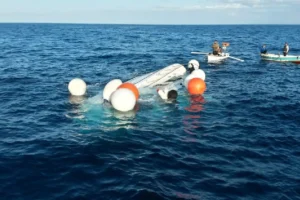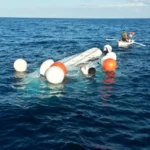Indications of the existence of the largest natural gas deposit in the Mediterranean, with a size of 30 trillion cubic feet – Interest from energy giant Chevron to get involved in the project – Countdown to the start of test drilling by ExxonMobil
The die is cast. All that remains now is for the drilling rig to be thrown in. On the Mediterranean seabed, near the deepest point in the Mediterranean Sea, the ExxonMobil-HellenIQ Energy consortium will try to bring to light natural gas from the two fields found in the two exploration plots.
March is the month of big news for the ‘Hellenic Hydrocarbons’ case. Within the month (no date has been set yet), a delegation of high-ranking Exxon executives will pass through the door of the Great Maximos building. According to “ProtoTHEMA”, they will inform the Prime Minister about the “encouraging data” on the deposits found in the plots west and southwest of Crete.
What are the encouraging facts?
According to the same sources, 2D and 3D surveys have shown that there are at least two gas deposits there of such a size that the Americans of Exxon (who have a majority stake in the exploitation of the leased land) will inform the Prime Minister that a second American oil giant, Chevron, is about to enter the game and that it is only a matter of time before test drilling begins.
Given that the ball is in the government’s court, given that these fields, which (based on the findings) are the largest in the Eastern Mediterranean and probably the last to be drilled (as the EU is running the energy transition with decoupling from fossil fuels by 2050), the ball is in the government’s court. As the issue concerns Europe’s energy autonomy, decisions are taken at the central level and, therefore, announcements are expected from the one who receives them, i.e. the Prime Minister, who is also expected to receive and respond to ExxonMobil’s request for exploratory drilling in March.
What the surveys have shown
In March, then, there will be tangible developments on the deposits. The ship “Sanco Swift”, chartered by ExxonMobil, dropped cables exploring for hydrocarbon deposits in an area covering about 6,500 of the total 30,000 kilometers that is the block south-southwest of Crete, and the analysis revealed strong evidence of two gas deposits: a giant one of 30 trillion feet and a smaller one of 3.5 trillion feet. In practice, therefore, we are talking about a field that is larger than the largest in the Mediterranean, the Zor field in Egypt, and the Israeli Leviathan and Tamar fields, which are 29 trillion cubic feet in siz
A short sidenote to explain what this would mean in practice if confirmed: the estimates of the emeritus researcher of the Geological Survey of Canada and professor emeritus of the Technical University of Crete Antonis Foskolos, that if one of the deposits has a natural gas reserve of about 10 trillion cubic meters, it will be able to cover the domestic needs, but also the annual needs of entire Europe, bringing to the Greek State revenues of about 10 billion euros. EUR 10 million per year for a century!












